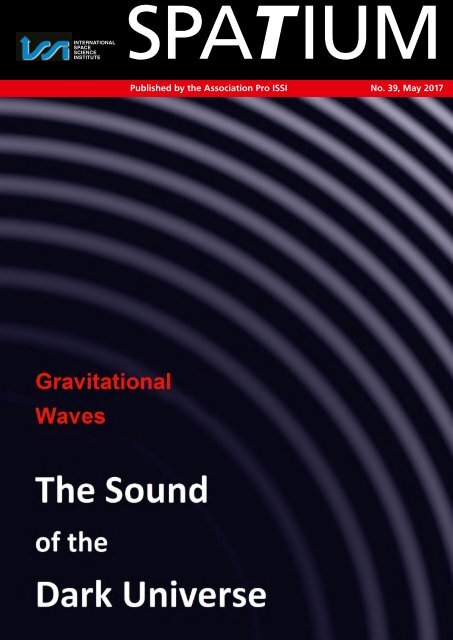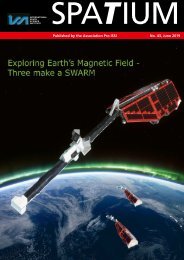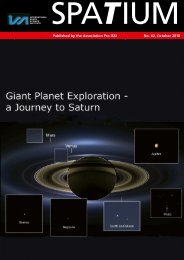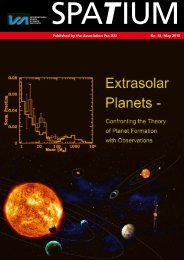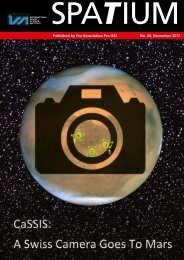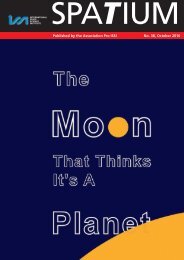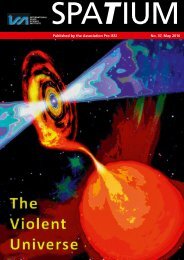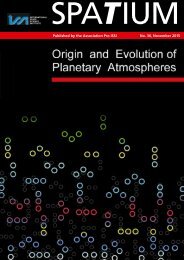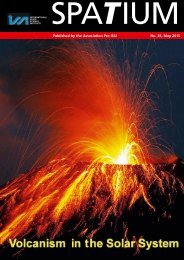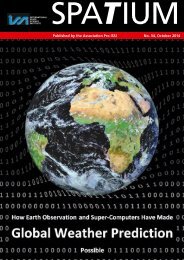Gravitational Waves - The Sound of the Dark Universe
Summary of the Pro ISSI talk by Karsten Danzmann (edited by H.Schlaepfer)
Summary of the Pro ISSI talk by Karsten Danzmann (edited by H.Schlaepfer)
- No tags were found...
Create successful ePaper yourself
Turn your PDF publications into a flip-book with our unique Google optimized e-Paper software.
INTERNATIONAL<br />
SPACE<br />
SCIENCE<br />
INSTITUTE<br />
SPATIUM<br />
Published by <strong>the</strong> Association Pro ISSI No. 39, May 2017
Editorial<br />
Today, dear reader, we invite you<br />
to an experience you have never<br />
had before. Let us visit a concert<br />
hall whose stage is not just a few<br />
planks, but ra<strong>the</strong>r <strong>the</strong> entire <strong>Universe</strong><br />
and <strong>the</strong> audience, to whom<br />
we humans have just belonged<br />
since autumn 2015, is a multitude<br />
<strong>of</strong> unknown beings scattered right<br />
throughout <strong>the</strong> <strong>Universe</strong> (if <strong>the</strong>re<br />
are any o<strong>the</strong>rs …). <strong>The</strong> principle<br />
performers are such prominent artists<br />
as neutron stars, black holes,<br />
etc. Similar, however, to earthly<br />
entertainers, <strong>the</strong>ir programme is<br />
devoted to <strong>the</strong> saga <strong>of</strong> birth and<br />
death, <strong>the</strong> two very vital <strong>the</strong>mes so<br />
mercilessly ruling our lives and<br />
that <strong>of</strong> <strong>the</strong> cosmic artists too.<br />
One hundred years ago, <strong>the</strong> idea <strong>of</strong><br />
gravitational waves saw its initial<br />
flimsy dawn. Discarded again by<br />
<strong>the</strong> most prominent luminaries at<br />
<strong>the</strong> time, it returned with clearer<br />
contours briefly, just to fall into<br />
oblivion again. Some decades later,<br />
its elusive shadow reappeared suddenly<br />
when astronomers observed<br />
a pair <strong>of</strong> stars, which obviously<br />
were emitting energy in <strong>the</strong> form<br />
<strong>of</strong> gravitational waves. That earned<br />
<strong>the</strong> lucky discoverers <strong>the</strong> Nobel<br />
Prize. Again, however, a lot <strong>of</strong><br />
time passed without an iota <strong>of</strong> a<br />
trace on <strong>the</strong> scene where in <strong>the</strong><br />
meantime an armada <strong>of</strong> engineers<br />
and scientists had ga<strong>the</strong>red to get<br />
hold <strong>of</strong> gravitational waves. <strong>The</strong>y<br />
made it finally on 14 September<br />
2015 when signals allowed <strong>the</strong>m to<br />
listen to <strong>the</strong> first sounds <strong>of</strong> <strong>the</strong> dark<br />
<strong>Universe</strong>. <strong>The</strong> piece was a threnody<br />
<strong>of</strong> two merging black holes,<br />
not quite on front stage, no, ra<strong>the</strong>r,<br />
an exciting 1.3 billion light years<br />
away. Only a few months later, a<br />
second performance enthused <strong>the</strong><br />
audience as an unexpected bonus<br />
suggesting that <strong>the</strong> artists might <strong>of</strong>fer<br />
such presentations frequently<br />
and accessibly to all those prepared<br />
to listen.<br />
To take full advantage <strong>of</strong> <strong>the</strong> new<br />
opportunity, a connoisseur is<br />
needed who helps interpret <strong>the</strong><br />
melodies. Fortunately, we have a<br />
renowned expert amongst us: Pr<strong>of</strong>essor<br />
Karsten Danzmann <strong>of</strong> <strong>the</strong><br />
Max Planck Institute for Gravitation<br />
Physics and <strong>the</strong> Institute for<br />
Gravitation Physics <strong>of</strong> <strong>the</strong> Leibniz<br />
Universität, Hannover. In his enthralling<br />
Pro ISSI talk on 12 October<br />
2016, he portrayed gravitational<br />
waves, <strong>the</strong>ir cosmic sources,<br />
<strong>the</strong> marvellous technologies required<br />
to grasp <strong>the</strong>m and <strong>the</strong><br />
messages <strong>the</strong>y convey. One thing<br />
became very clear in his talk: tremendous<br />
progress in a variety <strong>of</strong><br />
technological and scientific fields<br />
has been required to enable humankind<br />
to attend <strong>the</strong> universal<br />
concertos. In fact: a new concert<br />
season has begun.<br />
We are thankful to Pr<strong>of</strong>. Danzmann<br />
for his most valuable support<br />
in publishing <strong>the</strong> current issue <strong>of</strong><br />
Spatium and wish our readers<br />
some memorable moments in <strong>the</strong><br />
company <strong>of</strong> <strong>the</strong> cosmic philharmonic<br />
orchestra.<br />
Hansjörg Schlaepfer<br />
Brissago, May 2017<br />
Impressum<br />
ISSN 2297–5888 (Print)<br />
ISSN 2297–590X (Online)<br />
SPATIUM<br />
Published by <strong>the</strong><br />
Association Pro ISSI<br />
Association Pro ISSI<br />
Hallerstrasse 6, CH-3012 Bern<br />
Phone +41 (0)31 631 48 96<br />
see<br />
www.issibern.ch/pro-issi.html<br />
for <strong>the</strong> whole Spatium series<br />
President<br />
Pr<strong>of</strong>. Adrian Jäggi,<br />
University <strong>of</strong> Bern<br />
Layout and Publisher<br />
Dr. Hansjörg Schlaepfer<br />
CH-6614 Brissago<br />
Printing<br />
Stämpf li AG<br />
CH-3001 Bern<br />
SPATIUM 39 2
<strong>Gravitational</strong> <strong>Waves</strong>:<br />
<strong>the</strong> <strong>Sound</strong> <strong>of</strong> <strong>the</strong> <strong>Dark</strong> <strong>Universe</strong> 1<br />
by Pr<strong>of</strong>. Karsten Danzmann, Max Planck Institute for Gravitation Physics and<br />
Institute for Gravitation Physics <strong>of</strong> <strong>the</strong> Leibniz Universität, Hannover<br />
Prologue<br />
Albert Einstein Institute, Hannover<br />
14 September 2015<br />
Physicist Marco Drago sits calmly<br />
in front <strong>of</strong> his computer screen: he<br />
cannot know that this day will<br />
change his and all his colleagues’<br />
lives. Just before leaving for lunch,<br />
at 11:50, Marco notices an alert on<br />
his screen. This is not very exciting<br />
though: such alerts appear routinely<br />
at irregular intervals. On <strong>the</strong><br />
o<strong>the</strong>r hand, Marco also knows that<br />
an alarm might indicate a dramatic<br />
event billions <strong>of</strong> light years away.<br />
This is <strong>the</strong> stuff he and hundreds<br />
<strong>of</strong> colleagues all over <strong>the</strong> world<br />
have been chasing after for many<br />
years.<br />
In order to facilitate <strong>the</strong> physicists’<br />
job, a variety <strong>of</strong> s<strong>of</strong>tware packages<br />
monitors <strong>the</strong> incoming signals.<br />
Each <strong>of</strong> <strong>the</strong>se programmes can<br />
generate an alarm urging <strong>the</strong><br />
scientist on duty to have a closer<br />
look at <strong>the</strong> event. One <strong>of</strong> those<br />
packages aims at recognizing patterns<br />
possibly coming from two<br />
merging black holes. Ano<strong>the</strong>r system<br />
screens <strong>the</strong> signal in search <strong>of</strong><br />
orbiting neutron stars and still ano<strong>the</strong>r<br />
systems aims at characterizing<br />
<strong>the</strong> statistic properties <strong>of</strong> <strong>the</strong><br />
detector noise.<br />
No wonder, <strong>the</strong>refore, that Marco<br />
at first interprets <strong>the</strong> alarm as a system-generated<br />
check alert as he<br />
had seen so many before. Yet, what<br />
if this very alert indicated a real signal?<br />
Marco’s interest is aroused. He<br />
decides to inspect <strong>the</strong> waveform on<br />
<strong>the</strong> screen (Fig. 2) in more detail.<br />
No doubt, it is a marvellous signal,<br />
too exciting to be artificial. Hence,<br />
he calls his colleague Andrew<br />
Lundgren from across <strong>the</strong> hall. Andrew<br />
gets excited at once. <strong>The</strong>y<br />
decide to alarm <strong>the</strong>ir colleagues at<br />
<strong>the</strong> detector operations centre in<br />
<strong>the</strong> United States from where <strong>the</strong><br />
signal came from. Yet, it is <strong>the</strong><br />
middle <strong>of</strong> <strong>the</strong> night <strong>the</strong>re with only<br />
<strong>the</strong> night watch on duty, who, <strong>of</strong><br />
Fig. 1: Albert Einstein on <strong>the</strong> summit <strong>of</strong> his career, 1921. In <strong>the</strong> frame <strong>of</strong> his<br />
<strong>the</strong>ory <strong>of</strong> general relativity, he had predicted <strong>the</strong> existence <strong>of</strong> gravitational waves<br />
five years before. <strong>The</strong> science community <strong>the</strong>n had to wait a hundred years to see<br />
Einstein’s prediction verified experimentally in 2016. (Image credit: Ferdinand<br />
Schmutzer).<br />
1<br />
<strong>The</strong> text reports on a talk by Pr<strong>of</strong>. Karsten Danzmann for <strong>the</strong> Pro ISSI audience on 12 October 2016.<br />
It was prepared by Dr. Hansjörg Schlaepfer and reviewed by Pr<strong>of</strong>. Danzmann.<br />
SPATIUM 39 3
course, wonders about <strong>the</strong> excited<br />
nocturnal call. Upon returning to<br />
<strong>the</strong>ir <strong>of</strong>fice, all <strong>the</strong> scientists plunge<br />
into an examination <strong>of</strong> <strong>the</strong> mysterious<br />
signal concluding that it<br />
could indicate a real event indeed.<br />
At that moment, however, everyone<br />
remembers <strong>the</strong> Big Dog event<br />
when a similar signal caused so<br />
much turmoil. That waveform<br />
looked exactly as if it were coming<br />
from a pair <strong>of</strong> coalescing black<br />
holes in <strong>the</strong> constellation <strong>of</strong> <strong>the</strong> Big<br />
Dog: <strong>the</strong> seminal victory seemed<br />
within <strong>the</strong>ir grasp. In no time, an<br />
urgent Physical Review Letters paper<br />
is written and <strong>the</strong>n a secret envelope<br />
opened stating that <strong>the</strong> enigmatic<br />
Big Dog signal was an<br />
artificial injection. <strong>The</strong> huge common<br />
disappointment now prevents<br />
hundreds <strong>of</strong> people from talking to<br />
<strong>the</strong> media <strong>the</strong>reby granting a handful<br />
<strong>of</strong> senior specialists <strong>the</strong> time to<br />
analyse <strong>the</strong> event so rigorously as<br />
to exclude any false inter preta tion.<br />
Half a year later and exactly one<br />
hundred years after Albert Einstein’s<br />
publication <strong>of</strong> <strong>the</strong> general<br />
<strong>the</strong>ory <strong>of</strong> relativity, <strong>the</strong> historic<br />
first direct detection <strong>of</strong> a gravitational<br />
wave is presented at a press<br />
conference at Washington DC on<br />
11 February 2016. It was <strong>the</strong> last<br />
Fig. 2: <strong>The</strong> epoch making first signal <strong>of</strong> a gravitational wave as observed by <strong>the</strong><br />
Livingstone detector <strong>of</strong> <strong>the</strong> US Laser Interferometer <strong>Gravitational</strong> Observatory<br />
(LIGO) on 14 September 2015. <strong>The</strong> horizontal axis represents time, while <strong>the</strong> vertical<br />
axis shows <strong>the</strong> strain on <strong>the</strong> detector exerted by <strong>the</strong> gravitational wave in arbitrary<br />
units. <strong>The</strong> source <strong>of</strong> <strong>the</strong> waves is a pair <strong>of</strong> in-spiralling and <strong>the</strong>n merging<br />
black holes. Before merging at t=0.22 s, <strong>the</strong>ir orbit rate steadily increases producing<br />
a detector signal with steadily increasing frequency and amplitude. Upon merging,<br />
both, <strong>the</strong> frequency and <strong>the</strong> amplitude decay rapidly reflecting <strong>the</strong> remaining<br />
oscillations <strong>of</strong> <strong>the</strong> unified black hole. (Credit: Max-Planck-Institut für<br />
Gravitationsphysik)<br />
and final outcry <strong>of</strong> a pair <strong>of</strong> orbiting<br />
black holes when <strong>the</strong>y yelled<br />
just before merging into one single<br />
very massive black hole. Scientists<br />
rated <strong>the</strong>ir individual masses<br />
at 29 and 36 times <strong>the</strong> mass <strong>of</strong> <strong>the</strong><br />
Sun, while <strong>the</strong> resulting black hole<br />
holds 62 solar masses. Within a<br />
fraction <strong>of</strong> a second, <strong>the</strong> remaining<br />
three solar mass equivalents were<br />
converted into energy 2 . With <strong>the</strong><br />
speed <strong>of</strong> light, gravitational waves<br />
<strong>the</strong>n carried <strong>the</strong> energy through<br />
<strong>the</strong> <strong>Universe</strong>, where, 1.3 billion<br />
years later on Earth, <strong>the</strong>y squeezed<br />
<strong>the</strong> detectors’ 4-km long arms by<br />
a few 1/10,000 <strong>of</strong> <strong>the</strong> width <strong>of</strong> a<br />
proton. So dwarfish might be <strong>the</strong><br />
vestiges <strong>of</strong> a great event!<br />
Marco Drago’s and his colleagues’<br />
observation marks a turning point<br />
in science history comparable only<br />
with <strong>the</strong> moment when Galileo<br />
Galilei directed <strong>the</strong> first telescope<br />
to <strong>the</strong> sky in 1610. While Galilei<br />
used electromagnetic waves to observe<br />
<strong>the</strong> stars, <strong>the</strong> new carriers are<br />
gravitational waves that possess so<br />
radically different properties that<br />
<strong>the</strong>ir detection inaugurates a new<br />
epoch in astronomy.<br />
<strong>The</strong> current issue <strong>of</strong> Spatium is devoted<br />
to gravitational waves, <strong>the</strong>ir<br />
sources and <strong>the</strong> marvellous technologies<br />
required for observing<br />
<strong>the</strong>m. Over and above, this issue<br />
renders homage to Albert Einstein 3<br />
and <strong>the</strong> scientists <strong>of</strong> his time, who<br />
laid <strong>the</strong> cornerstone for our understanding<br />
<strong>of</strong> gravitational waves.<br />
2<br />
According to Einstein’s most famous equation E = mc² stating that energy E equals mass m times <strong>the</strong> speed <strong>of</strong> light c to <strong>the</strong><br />
square.<br />
3<br />
Albert Einstein, 1879, Ulm, Germany – 1955, Princeton, USA, <strong>the</strong>oretical physicist, Nobel Prize Laureate in physics,<br />
1922.<br />
SPATIUM 39 4
<strong>The</strong> History <strong>of</strong><br />
<strong>Gravitational</strong><br />
<strong>Waves</strong> 4<br />
<strong>The</strong> idea <strong>of</strong> gravitational waves is<br />
a child <strong>of</strong> <strong>the</strong> early 20th century’s<br />
physics: <strong>the</strong> first documented mention<br />
dates back to Henri Poincaré 5 .<br />
He suggested in early 1905 that –<br />
in analogy to an accelerating electrical<br />
charge producing electromagnetic<br />
waves – accelerated<br />
masses in a relativistic field <strong>the</strong>ory<br />
<strong>of</strong> gravity should produce gravitational<br />
waves.<br />
In February 1916, Albert Einstein<br />
took up <strong>the</strong> idea in <strong>the</strong> framework<br />
<strong>of</strong> an exchange <strong>of</strong> letters with Karl<br />
Schwarzschild 6 . In <strong>the</strong>se letters, he<br />
expressed pr<strong>of</strong>ound scepticism<br />
about <strong>the</strong> existence <strong>of</strong> <strong>the</strong> waves<br />
even although gravitational waves<br />
are a direct result <strong>of</strong> his general<br />
<strong>the</strong>ory <strong>of</strong> relativity. As a result, he<br />
submitted a first paper to <strong>the</strong> Prussian<br />
Academy <strong>of</strong> Sciences on<br />
22 June 1916. Later in June, he<br />
published a follow-up text in which<br />
he predicted <strong>the</strong> existence <strong>of</strong> gravitational<br />
waves travelling with <strong>the</strong><br />
speed <strong>of</strong> light, in analogy to electromagnetic<br />
radiation. This paper,<br />
though, contained a significant error,<br />
which he corrected in 1918,<br />
when he derived a new formula for<br />
<strong>the</strong> emission <strong>of</strong> gravitational waves<br />
that, apart from a factor <strong>of</strong> two, is<br />
still considered <strong>the</strong> correct one. His<br />
calculations also showed that <strong>the</strong>se<br />
waves have incredibly low amplitude<br />
eluding any observation with<br />
<strong>the</strong> technology available <strong>the</strong>n.<br />
Over time, and despite his earlier<br />
calculations, Einstein himself again<br />
came to doubt <strong>the</strong> existence <strong>of</strong><br />
gravitational waves to such an extent<br />
that, in 1936, he and his collaborator<br />
Nathan Rosen wrote a<br />
paper presenting this opinion. After<br />
a referee had spotted a mistake in<br />
<strong>the</strong>ir argument, Einstein withdrew<br />
it and published <strong>the</strong> corrected text<br />
in ano<strong>the</strong>r journal, yet with a completely<br />
different conclusion …<br />
From <strong>the</strong> 1920s to <strong>the</strong> early 1950s,<br />
gravitational waves were hardly a<br />
hot topic. Still, in <strong>the</strong> mid-1950s,<br />
general relativity saw a renaissance<br />
fur<strong>the</strong>red by considerable funding<br />
available to <strong>the</strong>oretical physics and<br />
by <strong>the</strong> increasing ability <strong>of</strong> scientists<br />
to cross international borders<br />
to exchange <strong>the</strong>ir ideas. Among <strong>the</strong><br />
most pressing questions now pursued<br />
were <strong>the</strong> existence and properties<br />
<strong>of</strong> gravitational waves.<br />
Heated discussions took place at<br />
<strong>the</strong> first international conference<br />
entirely dedicated to general relativity<br />
in Bern in 1955. Yet, based<br />
on work by Hermann Bondi 7 and<br />
Richard Feynman 8 , a broad consensus<br />
emerged that gravitational<br />
waves were a physical reality.<br />
Joseph Weber 9 <strong>of</strong> <strong>the</strong> University <strong>of</strong><br />
Maryland undertook <strong>the</strong> first attempts<br />
to observe <strong>the</strong>m. Weber began<br />
experimenting around 1960<br />
and after nearly a decade, he announced<br />
he has gained convincing<br />
evidence <strong>of</strong> <strong>the</strong>ir existence. Weber’s<br />
work had a significant impact<br />
on <strong>the</strong> scientific community,<br />
sparking a series <strong>of</strong> experiments<br />
designed to test his results. Even<br />
although none <strong>of</strong> <strong>the</strong>se confirmed<br />
Weber’s findings, new techniques<br />
and methodologies materialized<br />
that constitute <strong>the</strong> basis <strong>of</strong> today’s<br />
observatories.<br />
Indirect pro<strong>of</strong> for <strong>the</strong> existence <strong>of</strong><br />
gravitational waves discovered by<br />
chance in 1974 spurred <strong>the</strong> race<br />
fur<strong>the</strong>r. Joseph Taylor 10 and Russell<br />
Hulse 11 observed two closely<br />
orbiting stars, and found that, in<br />
contrast to classical Newtonian<br />
physics, <strong>the</strong> stars’ orbit period was<br />
steadily declining: <strong>the</strong> two bodies<br />
were rotating faster and faster<br />
about each o<strong>the</strong>r on increasingly<br />
tight orbits. <strong>The</strong> change was very<br />
small, some 75 µs/year, and was coherent<br />
with Einstein’s prediction<br />
that such a system would lose energy<br />
by <strong>the</strong> emission <strong>of</strong> gravitational<br />
waves. In fact, <strong>the</strong> observation<br />
complies fully with <strong>the</strong> general<br />
4<br />
After <strong>the</strong> Press Release by <strong>the</strong> Max-Planck-Institut für Wissenschaftsgeschichte: One Hundred Years <strong>of</strong> <strong>Gravitational</strong><br />
<strong>Waves</strong>: <strong>the</strong> long road from prediction to observation, 11 February 2016.<br />
5<br />
Jules Henri Poincaré, 1854, Nancy, Meur<strong>the</strong>-et-Moselle, France – 1912, Paris, French ma<strong>the</strong>matician, <strong>the</strong>oretical<br />
physicist and philosopher <strong>of</strong> science.<br />
6<br />
Karl Schwarzschild, 1873, Frankfurt am Main – 1916, Potsdam, German physicist and astronomer.<br />
7<br />
Sir Hermann Bondi, 1919, Vienna – 2005, Vienna, Anglo-Austrian ma<strong>the</strong>matician and cosmologist.<br />
8<br />
Richard Phillips Feynman, 1918, Queens, New York – 1988, Los Angeles, American <strong>the</strong>oretical physicist.<br />
9<br />
Joseph Weber, 1919, Paterson, New Jersey – 2000, Pittsburgh, Pennsylvania, US-American physicist.<br />
10<br />
Joseph Hooton Taylor, Jr., 1941, Philadelphia, US-American astrophysicist, Nobel Prize Laureate in physics, 1993.<br />
11<br />
Russell Alan Hulse, 1950, New York, US-American physicist, Nobel Prize laureate in physics, 1993.<br />
SPATIUM 39 5
<strong>the</strong>ory <strong>of</strong> relativity and, as this was<br />
<strong>the</strong> first, albeit indirect, pro<strong>of</strong>, it<br />
earned <strong>the</strong>m <strong>the</strong> Nobel Prize in<br />
1993. Many o<strong>the</strong>r binary systems<br />
have been found since all fitting in<br />
with <strong>the</strong>oretical predictions.<br />
<strong>The</strong> first direct detection by <strong>the</strong><br />
LIGO observatory in 2015 marks<br />
<strong>the</strong> next chapter in <strong>the</strong> history <strong>of</strong><br />
gravitational waves. This became<br />
possible not only as a result <strong>of</strong> tremendous<br />
technological progress<br />
but also thanks to extensive numerical<br />
simulations for all kinds <strong>of</strong><br />
events that produce gravitational<br />
waves. It paved <strong>the</strong> way to understanding<br />
<strong>the</strong> observed signals by assembling<br />
a catalogue <strong>of</strong> cosmic<br />
events and <strong>the</strong> associated signal<br />
patterns <strong>the</strong>y produce. Simulations<br />
<strong>of</strong> this sort required advancements<br />
in computing technology as well<br />
as <strong>the</strong>oretical physics giving way to<br />
<strong>the</strong> birth <strong>of</strong> an entirely new field<br />
<strong>of</strong> science: numerical relativity.<br />
<strong>The</strong> Secrets <strong>of</strong><br />
<strong>Gravitational</strong><br />
<strong>Waves</strong><br />
In <strong>the</strong> classical view <strong>of</strong> Isaac Newton,<br />
space and time are independent<br />
and invariable entities, and <strong>the</strong><br />
speed <strong>of</strong> light is a universal constant.<br />
<strong>The</strong>se concepts were pivotal<br />
to <strong>the</strong>oretical physics for some 200<br />
years. Yet, when scientists began<br />
pushing <strong>the</strong> limits fur<strong>the</strong>r out in<br />
<strong>the</strong> late 19th century, contradictions<br />
became apparent: for an observer<br />
moving with a significant<br />
fraction <strong>of</strong> <strong>the</strong> speed <strong>of</strong> light, <strong>the</strong><br />
velocity <strong>of</strong> electromagnetic waves<br />
would change under Newton’s<br />
paradigm. Several scientists had already<br />
attempted to overcome this<br />
hurdle when Albert Einstein began<br />
addressing <strong>the</strong> problem in<br />
1905. In <strong>the</strong> special <strong>the</strong>ory <strong>of</strong> relativity,<br />
he saw <strong>the</strong> speed <strong>of</strong> light as<br />
<strong>the</strong> unique universal constant<br />
while time dilates according to an<br />
observer’s velocity. In <strong>the</strong> subsequent<br />
general <strong>the</strong>ory <strong>of</strong> relativity,<br />
he introduced <strong>the</strong> impact <strong>of</strong> masses<br />
causing space to warp. Time that<br />
expands and space that bends were<br />
both ideas hard to accept 12 : no<br />
wonder <strong>the</strong> concept <strong>of</strong> gravitational<br />
waves was way out <strong>of</strong> <strong>the</strong><br />
grasp <strong>of</strong> <strong>the</strong> science community.<br />
We are going now to elaborate first<br />
on <strong>the</strong> nature <strong>of</strong> gravitational<br />
waves, <strong>the</strong>ir characteristics and<br />
later look at <strong>the</strong> various sources<br />
that generate <strong>the</strong>m.<br />
Fig. 3: <strong>The</strong> basics <strong>of</strong> gravitational<br />
waves. In <strong>the</strong> sketch, a sinusoidal gravitational<br />
wave is assumed to pass perpendicular<br />
to <strong>the</strong> plane <strong>of</strong> this sheet <strong>of</strong><br />
paper. <strong>The</strong> wave slightly warps <strong>the</strong> dimensions<br />
<strong>of</strong> <strong>the</strong> sheet as indicated by <strong>the</strong><br />
extremely exaggerated distortions <strong>of</strong> <strong>the</strong><br />
circles shown on <strong>the</strong> lower row. At t=t1,<br />
<strong>the</strong> strength is maximum and <strong>the</strong> sheet<br />
is squeezed so that <strong>the</strong> points on <strong>the</strong> circle<br />
now assume <strong>the</strong> form <strong>of</strong> a horizontally<br />
orientated ellipse. At t=t3, <strong>the</strong><br />
strength is maximum in <strong>the</strong> opposite direction<br />
and <strong>the</strong> sheet is distorted as indicated<br />
by <strong>the</strong> dots on <strong>the</strong> vertically oriented<br />
ellipse.<br />
12<br />
It is comforting to know that Newtonian physics are still today <strong>the</strong> right choice in all cases that exclude very high<br />
velocities and/or very dense concentration <strong>of</strong> masses.<br />
SPATIUM 39 6
<strong>The</strong> Nature <strong>of</strong> <strong>Gravitational</strong><br />
<strong>Waves</strong><br />
In Fig. 3, a hypo<strong>the</strong>tical gravitational<br />
wave penetrates this sheet <strong>of</strong><br />
paper. Let its strength over time be<br />
sinusoidal, as depicted in <strong>the</strong> upper<br />
part <strong>of</strong> <strong>the</strong> panel. This wave will<br />
slightly distort <strong>the</strong> paper as indicated<br />
on <strong>the</strong> lower row: <strong>the</strong> points<br />
on <strong>the</strong> circle will form ellipses in<br />
vertical and horizontal directions<br />
alternatively.<br />
As with o<strong>the</strong>r waves, a number <strong>of</strong><br />
parameters characterize gravitational<br />
waves:<br />
Amplitude: This is <strong>the</strong> size <strong>of</strong> <strong>the</strong><br />
wave, more precisely, <strong>the</strong> fraction<br />
<strong>of</strong> stretching or squeezing <strong>of</strong> <strong>the</strong><br />
circles on <strong>the</strong> lower row. <strong>The</strong> amplitude<br />
here is about 0.5, while real<br />
gravitational waves would result in<br />
values many orders <strong>of</strong> magnitude<br />
less. It is this unimaginably small<br />
effect that makes <strong>the</strong>ir direct detection<br />
a fantastic challenge.<br />
Velocity: This is <strong>the</strong> speed at which<br />
a specific point on <strong>the</strong> wave, for<br />
example a peak, travels through<br />
space. For <strong>the</strong> sake <strong>of</strong> simplicity,<br />
this is equal to <strong>the</strong> speed <strong>of</strong> light.<br />
Frequency: This is <strong>the</strong> number <strong>of</strong><br />
peaks and valleys passing per second.<br />
<strong>Gravitational</strong> waves are expected<br />
to exist in an extremely<br />
wide frequency spectrum ranging<br />
from practically zero up to some<br />
100 Hz.<br />
<strong>The</strong> Sources <strong>of</strong> <strong>Gravitational</strong><br />
<strong>Waves</strong><br />
In order to familiarize ourselves<br />
with <strong>the</strong> mechanics producing<br />
gravitational waves we are now<br />
looking at various scenarios and investigating<br />
whe<strong>the</strong>r <strong>the</strong> system will<br />
give <strong>of</strong>f energy in <strong>the</strong> form <strong>of</strong> gravitational<br />
waves. <strong>The</strong> reader is encouraged<br />
to consult Spatium 37 13 to<br />
get acquainted with <strong>the</strong> cosmic objects<br />
that create gravitational<br />
waves.<br />
<strong>The</strong> following objects do<br />
not radiate gravitational<br />
waves:<br />
– An isolated non-spinning<br />
solid object<br />
moving at a constant<br />
velocity does not radiate<br />
gravitational waves.<br />
– A perfectly symmetric<br />
spinning disk will not<br />
radiate waves. This is<br />
in accordance with <strong>the</strong><br />
conservation principle<br />
<strong>of</strong> angular momentum<br />
since gravitational<br />
waves extract energy<br />
from <strong>the</strong> system.<br />
<strong>The</strong> following (non-exhaustive)<br />
list names<br />
examples <strong>of</strong> objects that<br />
radiate gravitational<br />
waves:<br />
– Two objects orbiting<br />
each o<strong>the</strong>r: A planet orbiting<br />
<strong>the</strong> Sun radiates<br />
gravitational waves<br />
albeit at extremely low<br />
intensities.<br />
– A spinning nonaxisym<br />
metric planetoid,<br />
perhaps with a<br />
large bump or dimple<br />
on <strong>the</strong> equator, radiates<br />
very small amounts <strong>of</strong><br />
gravitational waves.<br />
– A supernova radiates<br />
gravitational waves if<br />
<strong>the</strong> explosion is not<br />
perfectly symmetrical.<br />
– Two orbiting black<br />
holes always radiate<br />
gravitational waves.<br />
13<br />
Spatium No. 37: <strong>The</strong> Violent <strong>Universe</strong> by Thierry Courvoisier, May 2016.<br />
SPATIUM 39 7
From <strong>the</strong>se lists, we can deduce in<br />
more general terms that gravitational<br />
waves are radiated by objects<br />
whose motion involves acceleration,<br />
provided that <strong>the</strong> motion is<br />
not perfectly spherically symmetric<br />
(like an expanding or contracting<br />
sphere) or rotation, provided<br />
that <strong>the</strong> object is not rotationally<br />
symmetric (like a spinning disk or<br />
sphere).<br />
Let us now look at some specific<br />
sources <strong>of</strong> gravitational waves:<br />
Binaries<br />
A binary (system) is a pair <strong>of</strong> cosmic<br />
objects orbiting each o<strong>the</strong>r.<br />
<strong>The</strong> Hulse-Taylor binary mentioned<br />
above is a typical example<br />
<strong>the</strong>re<strong>of</strong>. It contains a pair <strong>of</strong> neutron<br />
stars <strong>of</strong> which one is a pulsar<br />
emitting electromagnetic radiation<br />
while <strong>the</strong> o<strong>the</strong>r does not. Each one<br />
has about 1.5 solar mass equivalents<br />
and <strong>the</strong>y orbit each o<strong>the</strong>r within a<br />
period <strong>of</strong> a mere 7.75 hours. <strong>The</strong>y<br />
are 21,000 light years from us. <strong>The</strong><br />
system generates gravitational<br />
waves that withdraw energy from<br />
<strong>the</strong> binary causing <strong>the</strong> orbits to<br />
come closer and closer eventually<br />
leading to a merger in some<br />
300 million years.<br />
A great number <strong>of</strong> white dwarf 14<br />
binaries exists in <strong>the</strong> <strong>Universe</strong>, circling<br />
each o<strong>the</strong>r on extremely tight<br />
orbits. <strong>The</strong>y are typical sources <strong>of</strong><br />
gravitational waves. Upon reaching<br />
orbital distances in <strong>the</strong> order <strong>of</strong><br />
10,000 km, <strong>the</strong>y will merge and<br />
explode in a supernova <strong>the</strong>reby<br />
ending <strong>the</strong> emission <strong>of</strong> gravitational<br />
waves.<br />
Ano<strong>the</strong>r important category are<br />
pairs <strong>of</strong> black holes. <strong>The</strong>y emit<br />
gravitational waves during <strong>the</strong>ir<br />
in-spiral, merger, and ringdown<br />
phases. <strong>The</strong> largest amplitude <strong>of</strong><br />
emission occurs during <strong>the</strong> merger<br />
phase. In fact, it was this type <strong>of</strong><br />
event that made <strong>the</strong> first observation<br />
<strong>of</strong> gravitational waves in 2015<br />
possible, see Fig. 2.<br />
Supernovae<br />
A supernova is one <strong>of</strong> <strong>the</strong> last stellar<br />
evolutionary stages <strong>of</strong> a massive<br />
star’s life, whose dramatic destruction<br />
occurs during a final titanic<br />
explosion. This explosion can happen<br />
in one <strong>of</strong> many ways, but in all<br />
<strong>of</strong> <strong>the</strong>m, a significant proportion<br />
<strong>of</strong> <strong>the</strong> star’s matter is blown away<br />
into surrounding space at extremely<br />
high velocities. Unless<br />
<strong>the</strong>re is perfect spherical symmetry<br />
in <strong>the</strong>se explosions (i.e., unless<br />
matter is jettisoned out evenly in<br />
all directions), <strong>the</strong> supernova will<br />
radiate energy strongly for a certain<br />
time by emitting gravitational<br />
waves.<br />
Rotating Neutron Stars<br />
Single rotating neutron stars are a<br />
fur<strong>the</strong>r source <strong>of</strong> gravitational<br />
waves. In general, however, a spinning<br />
neutron star will not emit a<br />
lot <strong>of</strong> gravitational radiation because<br />
<strong>the</strong>se extremely dense objects<br />
have such a strong gravitational<br />
field that <strong>the</strong>ir shape is almost perfectly<br />
spherical. In some cases,<br />
<strong>the</strong>re might be slight deformities<br />
on <strong>the</strong> surface: perhaps bumps extending<br />
no more than 0.1 m above<br />
<strong>the</strong> surface. This makes <strong>the</strong> neutron<br />
star slightly asymmetric giving<br />
rise to <strong>the</strong> emission <strong>of</strong> gravitational<br />
waves as long as <strong>the</strong><br />
deformities continue to exist.<br />
<strong>The</strong> Early <strong>Universe</strong><br />
Many models addressing <strong>the</strong> earliest<br />
phases <strong>of</strong> <strong>the</strong> <strong>Universe</strong> postulate<br />
an inflationary epoch when<br />
space expanded rapidly in a very<br />
short time. <strong>The</strong> quantum fluctuations<br />
in this expansion may have<br />
emitted gravitational radiation that<br />
should still be detectable today as<br />
a gravitational wave background.<br />
Even though this background signal<br />
is too weak for any currently<br />
operational detector, <strong>the</strong>re are<br />
many o<strong>the</strong>r scenarios for what<br />
might have happened in <strong>the</strong> early<br />
<strong>Universe</strong>, producing pronounced<br />
signals that may be detectable with<br />
LISA and future ground-based detectors.<br />
Such observations could<br />
provide unprecedented insights<br />
into <strong>the</strong> earliest phases <strong>of</strong> <strong>the</strong><br />
emerging <strong>Universe</strong>.<br />
14<br />
A white dwarf is an old very dense star with a mass comparable to that <strong>of</strong> <strong>the</strong> Sun, while its volume is comparable to that<br />
<strong>of</strong> Earth. It has collapsed to that small size when all <strong>the</strong> fusion processes had ended.<br />
SPATIUM 39 8
Observing <strong>Gravitational</strong><br />
<strong>Waves</strong><br />
In Einstein’s times, gravitational<br />
waves were way out <strong>of</strong> <strong>the</strong> reach <strong>of</strong><br />
any available technology. However,<br />
in <strong>the</strong> meantime, progress in<br />
various fields has made direct detection<br />
<strong>of</strong> <strong>the</strong>se waves feasible. In<br />
fact, several ground-based systems<br />
are currently ei<strong>the</strong>r operational or<br />
are planned to enter service soon.<br />
Technologies for space-based detector<br />
systems have become available<br />
too. Unfortunately, our planet<br />
is not well suited to serve as <strong>the</strong> basis<br />
for such experiments, at least in<br />
certain frequency bands. <strong>The</strong> activity<br />
<strong>of</strong> <strong>the</strong> tectonic plates, Earthquakes<br />
as well as man-made sources<br />
<strong>of</strong> tiny vibrations, such as cars or<br />
trains passing by, lead to detector<br />
signals which are orders <strong>of</strong> magnitude<br />
larger than gravitational<br />
waves. Hence, <strong>the</strong> silver bullet for<br />
getting hold <strong>of</strong> gravitational waves<br />
in <strong>the</strong>ir entire spectrum are spaceborne<br />
detectors.<br />
All detectors build on <strong>the</strong> effect<br />
that gravitational waves exert on<br />
free-floating test masses. This effect<br />
consists <strong>of</strong> tiny changes in <strong>the</strong><br />
distances between <strong>the</strong> test cubes.<br />
Still, <strong>the</strong>se changes are extremely<br />
small; say in <strong>the</strong> order <strong>of</strong> 10 –18 m<br />
for ground-based detectors and<br />
10 –11 m for space-based detectors.<br />
To detect such small dimensions interferometric<br />
systems in <strong>the</strong>ir most<br />
sophisticated forms come into play.<br />
Let us look <strong>the</strong>refore briefly at <strong>the</strong><br />
main principles <strong>of</strong> interferometry<br />
but also at <strong>the</strong> progress required to<br />
interpret <strong>the</strong> resulting signals.<br />
Key Technologies<br />
Interferometry<br />
Interferometry is a generic term for<br />
techniques in which <strong>the</strong> wave nature<br />
<strong>of</strong> electromagnetic radiation<br />
plays <strong>the</strong> key role. When two wave<br />
fronts with <strong>the</strong> same frequency<br />
combine, <strong>the</strong> resulting intensity<br />
pattern is determined by <strong>the</strong> phase<br />
difference between <strong>the</strong> two waves:<br />
waves that are in phase will undergo<br />
constructive interference<br />
while waves <strong>of</strong> opposite phase will<br />
incur destructive interference (see<br />
Fig. 4). <strong>Waves</strong>, which are nei<strong>the</strong>r<br />
completely in phase nor completely<br />
in <strong>the</strong> opposite phase, will produce<br />
intermediate intensity patterns allowing<br />
for determination <strong>of</strong> <strong>the</strong>ir<br />
relative phase difference.<br />
<strong>The</strong> principle <strong>of</strong> interferometry<br />
saw <strong>the</strong> light <strong>of</strong> <strong>the</strong> day in <strong>the</strong> late<br />
19th century. Albert Michelson 15<br />
invented <strong>the</strong> concept when he tried<br />
to prove <strong>the</strong> existence <strong>of</strong> a universal<br />
e<strong>the</strong>r as <strong>the</strong> carrier <strong>of</strong> light, an<br />
attempt, which <strong>of</strong> course was<br />
bound to fail. Yet, his instrument<br />
was a seminal invention, which<br />
during time saw continuous improvements<br />
by later authors. Fig. 5<br />
shows <strong>the</strong> principle <strong>of</strong> <strong>the</strong> Michel-<br />
Fig. 4: <strong>The</strong> basic principles <strong>of</strong> <strong>the</strong> interference <strong>of</strong> waves. When two waves <strong>of</strong><br />
<strong>the</strong> same frequency meet, <strong>the</strong>y interfere ei<strong>the</strong>r constructively (if <strong>the</strong>y are in phase),<br />
<strong>the</strong>reby adding <strong>the</strong>ir amplitudes, or destructively (if <strong>the</strong>y are in opposite phase)<br />
<strong>the</strong>reby subtracting <strong>the</strong>ir amplitude. (Credit: www.explainthatstuff.com)<br />
15<br />
Albert Abraham Michelson, 1852, Strelno, Poland – 1931, Pasadena, USA, US-American physicist with German roots<br />
and Nobel Prize Laureate in physics 1907.<br />
SPATIUM 39 9
son interferometer. For a gravitational<br />
wave detector, <strong>the</strong> mirrors<br />
are <strong>the</strong> test masses, so that any<br />
change <strong>of</strong> <strong>the</strong> distance between<br />
<strong>the</strong>m due to a gravitational wave<br />
changes <strong>the</strong> length <strong>of</strong> <strong>the</strong> light<br />
path, which in turn is measured by<br />
interference with <strong>the</strong> o<strong>the</strong>r beam.<br />
For instance, as <strong>the</strong> wavelength <strong>of</strong><br />
red light is in <strong>the</strong> order <strong>of</strong> 0.6 µm,<br />
displacements <strong>of</strong> less than say 0.1<br />
µm can be resolved.<br />
Yet, this value is still a long way <strong>of</strong>f<br />
from resolving <strong>the</strong> tiny shifts caused<br />
by gravitational waves. In order to<br />
enhance a Michelson interferometer’s<br />
capabilities, interferometers<br />
nowadays make use <strong>of</strong> an invention<br />
by Charles Fabry 16 and Alfred<br />
Perot 17 who added fur<strong>the</strong>r optical<br />
elements constituting Fabry-Perot<br />
cavities (not shown in Fig. 5). <strong>The</strong><br />
idea is to allow <strong>the</strong> two beams between<br />
<strong>the</strong> beam splitter and <strong>the</strong> respective<br />
mirrors to pass several hundred<br />
times back and forth instead<br />
<strong>of</strong> just once. This multiplies <strong>the</strong> effective<br />
displacement <strong>of</strong> <strong>the</strong> mirrors<br />
by <strong>the</strong> same factor <strong>the</strong>reby greatly<br />
enhancing <strong>the</strong> sensitivity <strong>of</strong> <strong>the</strong><br />
system.<br />
Yet, with increasing sensitivity,<br />
spurious noise tends to appear that<br />
can mask <strong>the</strong> signal caused by gravitational<br />
waves. For instance, <strong>the</strong><br />
light produced by a laser consists<br />
<strong>of</strong> a flow <strong>of</strong> photons. However,<br />
<strong>the</strong>y come at random, just like <strong>the</strong><br />
droplets <strong>of</strong> a rainfall. This leads to<br />
high-frequency noise in <strong>the</strong> output<br />
<strong>of</strong> <strong>the</strong> detector. In addition, for<br />
sufficiently high laser power, <strong>the</strong><br />
photons reflected by <strong>the</strong> mirrors<br />
Fig 5: <strong>The</strong> basic configuration <strong>of</strong> a Michelson Interferometer. A light source<br />
(today mostly lasers) emits light in <strong>the</strong> direction <strong>of</strong> <strong>the</strong> beam splitter. This element<br />
produces two beams, <strong>of</strong> which one travels ahead in <strong>the</strong> same direction as before,<br />
while <strong>the</strong> second is reflected by 90°. Both beams travel towards <strong>the</strong> mirrors, which<br />
reflect <strong>the</strong>m back towards <strong>the</strong> beam splitter, which acts on <strong>the</strong> beams again. Finally,<br />
both beams travel towards <strong>the</strong> detector where <strong>the</strong>y interfere. <strong>The</strong> test masses’ surfaces<br />
act as mirrors, so that any displacement <strong>of</strong> <strong>the</strong> test cubes causes a change in<br />
<strong>the</strong> path lengths <strong>of</strong> <strong>the</strong> beams. <strong>The</strong> difference between <strong>the</strong> two optical paths makes<br />
<strong>the</strong> interference pattern change and <strong>the</strong> detector deliver an output.<br />
on <strong>the</strong> test masses transfer a random<br />
momentum, which tends to<br />
disguise a signal at lower frequencies.<br />
External effects, such as seismic<br />
turbulences and o<strong>the</strong>r forms <strong>of</strong><br />
environmental vibrations acting on<br />
<strong>the</strong> test masses, are sources <strong>of</strong> detector<br />
noise. In order to suppress<br />
this type <strong>of</strong> noise, two (or more)<br />
widely spaced sites are used. <strong>The</strong><br />
stochastic environmental noise<br />
will be different at each site so that<br />
appropriate algorithms are able to<br />
suppress it to some extent. On <strong>the</strong><br />
o<strong>the</strong>r hand, any gravitational wave<br />
signal will be <strong>the</strong> same at all sites<br />
(aside from an eventual time shift).<br />
All <strong>the</strong>se – and many o<strong>the</strong>r – effects<br />
must be taken into account<br />
before an observatory becomes<br />
able to monitor gravitational<br />
waves. As an engineer said: <strong>The</strong><br />
16<br />
Maurice Paul Auguste Charles Fabry, 1867, Marseille – 1945, Paris, French physicist.<br />
17<br />
Jean-Baptiste Alfred Perot, 1863, Metz, France – 1925, Paris, French physicist.<br />
SPATIUM 39 10
fight for detecting gravitational waves is<br />
<strong>the</strong> battle against <strong>the</strong> noise.<br />
If a signal now appears in <strong>the</strong> detector,<br />
<strong>the</strong> next major issue is to interpret<br />
it. Unfortunately, telescopes<br />
cannot observe <strong>the</strong> sources <strong>of</strong> gravitational<br />
waves, whe<strong>the</strong>r <strong>the</strong>y are<br />
black holes or neutron stars. This<br />
prevents any visual corroboration<br />
<strong>of</strong> an observed event and requires<br />
<strong>the</strong> new scientific field <strong>of</strong> numeric<br />
relativity to come into play. Let us<br />
<strong>the</strong>refore elaborate briefly on <strong>the</strong><br />
technique <strong>of</strong> data filtering and data<br />
interpretation.<br />
Matched Filtering<br />
Lacking any visual validation option,<br />
we have to rely solely on<br />
Einstein’s field equations, which –<br />
notwithstanding <strong>the</strong>ir complexity<br />
– allow us to calculate <strong>the</strong> signals<br />
produced by cosmic events. Based<br />
on solving <strong>the</strong> field equations, a<br />
catalogue <strong>of</strong> such cosmic events<br />
and <strong>the</strong>ir associated signal patterns<br />
is prepared. To interpret a specific<br />
signal, it is compared with <strong>the</strong> signals<br />
stored in <strong>the</strong> catalogue and <strong>the</strong><br />
template best matching <strong>the</strong> observed<br />
signal defines <strong>the</strong> event<br />
observed.<br />
<strong>The</strong> process <strong>of</strong> comparing <strong>the</strong> signal<br />
with <strong>the</strong> templates is called<br />
matched filtering: many different<br />
filters compare <strong>the</strong> incoming signal<br />
with <strong>the</strong> stored templates. As<br />
<strong>the</strong>re are thousands <strong>of</strong> such filters<br />
operating simultaneously, extremely<br />
powerful data processing<br />
systems are key to success.<br />
<strong>The</strong> templates <strong>the</strong>mselves are <strong>the</strong><br />
achievement <strong>of</strong> numerical relativity.<br />
Scientists model <strong>the</strong> cosmic<br />
processes by solving Einstein’s field<br />
Fig. 6: Overview <strong>of</strong> <strong>the</strong> worldwide<br />
gravitational wave observatories<br />
network. In Europe, <strong>the</strong>re is <strong>the</strong> joint<br />
German-British GEO600 programme<br />
and <strong>the</strong> French-Italian Virgo project. In<br />
<strong>the</strong> US, <strong>the</strong>re is <strong>the</strong> Laser Interferometer<br />
<strong>Gravitational</strong> Wave Observatory<br />
LIGO with its two detector sites, which<br />
are planned to be upgraded by a third<br />
LIGO Observatory in India. In Japan,<br />
<strong>the</strong>re is <strong>the</strong> Kamioka <strong>Gravitational</strong><br />
Wave Detector (KAGRA) project <strong>of</strong> <strong>the</strong><br />
gravitational wave studies group at <strong>the</strong><br />
Institute for Cosmic Ray Research <strong>of</strong><br />
<strong>the</strong> University <strong>of</strong> Tokyo. <strong>The</strong> planned<br />
integration <strong>of</strong> all <strong>the</strong>se systems into one<br />
network will greatly enhance <strong>the</strong> sensitivity<br />
<strong>of</strong> <strong>the</strong> individual observatories.<br />
(Credit: Max-Planck-Institut für<br />
Gravitationsphysik)<br />
SPATIUM 39 11
equations and look at <strong>the</strong> pattern<br />
<strong>of</strong> <strong>the</strong> resulting gravitational wave.<br />
For instance, <strong>the</strong> evolution <strong>of</strong> a binary<br />
black hole system is simulated<br />
during its in-spiral and merging<br />
phases. <strong>The</strong> resulting gravitational<br />
wave signal reflects <strong>the</strong> specific<br />
process, <strong>the</strong> properties <strong>of</strong> <strong>the</strong> black<br />
holes and so on, and finally gives<br />
rise to just one template. O<strong>the</strong>r<br />
combinations <strong>of</strong> black holes with<br />
different masses cause different signal<br />
patterns and hence produce<br />
o<strong>the</strong>r templates. Thus, <strong>the</strong> interpretation<br />
<strong>of</strong> a signal from two<br />
merging black holes requires many<br />
different templates and <strong>the</strong>re are<br />
many different events occurring in<br />
<strong>the</strong> <strong>Universe</strong> …<br />
A final remark reminds us <strong>of</strong> a surprising<br />
commonality across <strong>the</strong><br />
<strong>Universe</strong>: <strong>the</strong> pattern shown in<br />
Fig. 2 is a so-called chirp-signal. It<br />
is characterized by increasing frequency<br />
and amplitude over time<br />
up to a certain point from where<br />
on both frequency and amplitude<br />
decay quickly. Comparison with<br />
<strong>the</strong> catalogue <strong>of</strong> templates allowed<br />
it to be associated with <strong>the</strong> final<br />
stage <strong>of</strong> two merging black holes:<br />
this is <strong>the</strong> sound <strong>of</strong> <strong>the</strong> dark <strong>Universe</strong>.<br />
Yet, it is not only <strong>the</strong> last<br />
squeal <strong>of</strong> two merging black holes<br />
that takes <strong>the</strong> shape <strong>of</strong> such a chirp<br />
signal; birds also use <strong>the</strong>m in <strong>the</strong>ir<br />
songs, bats in search for <strong>the</strong>ir prey<br />
use <strong>the</strong>m as do whales in <strong>the</strong>ir<br />
communications and even humans<br />
in <strong>the</strong>ir speech: this is also <strong>the</strong><br />
sound <strong>of</strong> <strong>the</strong> living <strong>Universe</strong>!<br />
Fig. 7: <strong>The</strong> two LIGO stations in <strong>the</strong> US are separated by 3,002 km. This great<br />
distance helps supress <strong>the</strong> noise caused by natural sources (tectonic activities) as well<br />
as human activities, such as that caused by trains or traffic. (Credit: Max-Planck-<br />
Institut für Gravitationsphysik)<br />
Operational Systems<br />
Ground-Based <strong>Gravitational</strong><br />
<strong>Waves</strong> Observatories<br />
Several observatories for detecting<br />
gravitational waves are ei<strong>the</strong>r in an<br />
advanced stage <strong>of</strong> development or<br />
now operational (Fig. 6). In Europe,<br />
<strong>the</strong>re are <strong>the</strong> German-British<br />
GEO600 system and <strong>the</strong> Italian-<br />
French Virgo system. Two fur<strong>the</strong>r<br />
systems are under construction in<br />
Japan and India. Finally, in <strong>the</strong><br />
United States, <strong>the</strong>re is <strong>the</strong> Laser Interferometer<br />
<strong>Gravitational</strong> Wave<br />
Observatory (LIGO). <strong>The</strong>se programmes<br />
are collaborating in a<br />
worldwide network to enhance<br />
<strong>the</strong>ir capabilities for <strong>the</strong> suppression<br />
<strong>of</strong> local detector noise.<br />
As <strong>the</strong> first gravitational wave appeared<br />
in <strong>the</strong> LIGO detectors, we<br />
are going now to present a brief<br />
overview <strong>of</strong> this programme.<br />
LIGO is a huge international endeavour<br />
bringing more than 80 scientific<br />
institutes in 15 countries<br />
with more than 1,000 scientists toge<strong>the</strong>r.<br />
Both, <strong>the</strong> German Max-<br />
Planck-Institute for <strong>Gravitational</strong><br />
Physics and <strong>the</strong> Institute for <strong>Gravitational</strong><br />
Physics at <strong>the</strong> Leibniz<br />
Universität Hannover are important<br />
members <strong>of</strong> <strong>the</strong> family not<br />
only on <strong>the</strong> level <strong>of</strong> key hardware<br />
deliveries but also in <strong>the</strong> area <strong>of</strong><br />
data processing.<br />
LIGO comprises four distinct facilities<br />
across <strong>the</strong> United States:<br />
two gravitational wave detector<br />
sites (<strong>the</strong> interferometers proper)<br />
SPATIUM 39 12
and two University research centres,<br />
namely <strong>the</strong> California Institute<br />
<strong>of</strong> Technology in Pasadena CA<br />
and <strong>the</strong> Massachusetts Institute <strong>of</strong><br />
Technology (MIT), in Cambridge<br />
MA. <strong>The</strong> two interferometers are<br />
located in Washington (LIGO<br />
Hanford, WA) and on <strong>the</strong> 3,002<br />
km distant Louisiana site (LIGO<br />
Livingston, LA), Fig. 7. LIGO<br />
builds around two giant Michelson<br />
interferometers with two arms<br />
<strong>of</strong> 4 km length each. Fabry-Perot<br />
cavities in <strong>the</strong> optical path allow<br />
<strong>the</strong> light beams to travel <strong>the</strong> arms<br />
back and forth 280 times. This<br />
leads to an effective optical path<br />
length <strong>of</strong> 2,240 km.<br />
<strong>The</strong> detector signals are not only<br />
sent to <strong>the</strong> academic centres in <strong>the</strong><br />
US, but also to <strong>the</strong> Albert Einstein<br />
Institute in Hannover where <strong>the</strong><br />
world’s largest dedicated computer<br />
cluster ATLAS for gravitational<br />
wave data analyses is available. This<br />
site receives data also from <strong>the</strong><br />
French-Italian Virgo observatory<br />
in Pisa. <strong>The</strong> cluster is amongst <strong>the</strong><br />
most powerful computers worldwide:<br />
it features more than 5 × 10 15<br />
byte hard disk capacity and reaches<br />
an incredible speed <strong>of</strong> about 4 × 10 14<br />
flops per second. It is this facility<br />
that produced <strong>the</strong> first hot alert noticed<br />
by Marco Drago.<br />
Space-Based <strong>Gravitational</strong><br />
<strong>Waves</strong> Observatories<br />
<strong>The</strong> shaky Earth’s surface is a challenging<br />
support for gravitational<br />
wave observatories. Space <strong>of</strong>fers an<br />
attractive yet no less demanding alternative:<br />
<strong>the</strong> size <strong>of</strong> a space-borne<br />
interferometer is virtually unlimited<br />
and <strong>the</strong> platforms suffer much<br />
Fig. 8: <strong>The</strong> LISA Pathfinder concept builds on <strong>the</strong> layout <strong>of</strong> ESA’s evolved Laser<br />
Interferometer Space Antenna (eLISA). In fact, it concentrates on one single platform<br />
all <strong>the</strong> functions required for implementing <strong>the</strong> final eLISA observatory. In<br />
<strong>the</strong> eLISA programme, <strong>the</strong> two test masses that, toge<strong>the</strong>r with mirrors and beam<br />
splitters, constitute one Michelson interferometer fly on different spacecraft several<br />
million kilometres apart. In contrast, <strong>the</strong> Pathfinder concept concentrates <strong>the</strong>m on<br />
one single spacecraft where <strong>the</strong> test cubes are a mere 38 cm apart. This approach is<br />
feasible, as <strong>the</strong> principle <strong>of</strong> interferometry does not depend on <strong>the</strong> length <strong>of</strong> its arms.<br />
(Image courtesy: Stefano Vitale, Max-Planck-Institut für Gravitationsphysik)<br />
less disturbances. This assessment<br />
as well as bilateral efforts towards<br />
ground-based observatories in Europe<br />
prompted <strong>the</strong> scientific community<br />
to propose to <strong>the</strong> European<br />
Space Agency ESA <strong>the</strong> planning <strong>of</strong><br />
a dedicated space-based observatory.<br />
In 1995, <strong>the</strong> Agency selected<br />
<strong>the</strong> Laser Interferometer Space Antenna<br />
(LISA) proposal as one <strong>of</strong><br />
<strong>the</strong>ir major forthcoming science<br />
projects. Initially, it was meant as<br />
a co-operative undertaking with<br />
NASA, but upon <strong>the</strong>ir withdrawal<br />
from <strong>the</strong> programme in 2011, LISA<br />
was studied as an ESA-only mission<br />
for a number <strong>of</strong> years. This effort<br />
led to <strong>the</strong> evolved Laser Interferometer<br />
Space Antenna (eLISA).<br />
Recently, NASA has reentered <strong>the</strong><br />
LISA programme and <strong>the</strong> LISA<br />
mission is now being developed for<br />
<strong>the</strong> L3 large mission flight opportunity<br />
with a launch in <strong>the</strong> early<br />
2030s. To cope with <strong>the</strong> demanding<br />
technological challenges, ESA<br />
resolved to adopt a phased approach<br />
by first implementing a<br />
pro<strong>of</strong>-<strong>of</strong>-concept mission, <strong>the</strong><br />
LISA Pathfinder (LPF), before embarking<br />
on <strong>the</strong> LISA programme<br />
proper.<br />
SPATIUM 39 13
LISA Pathfinder<br />
LISA Pathfinder is a downscaled<br />
version <strong>of</strong> <strong>the</strong> LISA concept (Fig. 8):<br />
it contains only two (instead <strong>of</strong> six)<br />
free-floating test masses in one single<br />
(instead <strong>of</strong> three separate)<br />
spacecraft several million kilometres<br />
apart. <strong>The</strong> test cubes are made<br />
<strong>of</strong> a gold-platinum alloy (Fig. 9). As<br />
with LISA, an interferometer monitors<br />
<strong>the</strong>ir relative distance with<br />
extreme precision.<br />
<strong>The</strong> LISA Pathfinder spacecraft<br />
launched on 3 December 2015; <strong>the</strong><br />
scientific phase started on 1 March<br />
2016 and on 7 June 2016, ESA presented<br />
<strong>the</strong> first scientific results. In<br />
short, it was found that <strong>the</strong> two test<br />
cubes were indeed falling freely<br />
through space unperturbed by any<br />
external spurious effect to a degree<br />
far beyond expectations. This result<br />
confirmed <strong>the</strong> feasibility <strong>of</strong> <strong>the</strong><br />
LISA concept as well as <strong>the</strong> readiness<br />
<strong>of</strong> <strong>the</strong> required technologies.<br />
Extensive testing during <strong>the</strong> subsequent<br />
months allowed scientists<br />
to gain fur<strong>the</strong>r experimental experience<br />
to optimize <strong>the</strong> system’s sensitivity.<br />
In December 2016, <strong>the</strong><br />
mission was granted a six month<br />
extension during which scientists<br />
and engineers exploited <strong>the</strong> platform<br />
as a sophisticated physics laboratory<br />
and pushed <strong>the</strong> experiment<br />
to <strong>the</strong> limit in preparation for ESA’s<br />
future space observatory <strong>of</strong> gravitational<br />
waves.<br />
Fig. 9: This artist’s impression illustrates<br />
<strong>the</strong> LISA Technology Package<br />
on <strong>the</strong> LISA Pathfinder spacecraft.<br />
Each <strong>of</strong> <strong>the</strong> two yellowish containers<br />
houses a gold-platinum test cube <strong>of</strong><br />
which one is visible in <strong>the</strong> cutaway on<br />
<strong>the</strong> right. <strong>The</strong> optical bench holding <strong>the</strong><br />
interferometer is shown in between <strong>the</strong><br />
containers. It is made <strong>of</strong> extremely stable<br />
20 × 20 cm zerodur ceramic glass<br />
holding 22 mirrors and beam splitters<br />
directly bonded to its surface. <strong>The</strong> laser<br />
beams measure <strong>the</strong> cubes’ motion, position,<br />
and orientation without any<br />
physical contact. Various procedures<br />
and controls create an environment free<br />
<strong>of</strong> any external effect except for gravity.<br />
<strong>The</strong> LISA Pathfinder mission featured<br />
<strong>the</strong> first high-precision interferometric<br />
tracking <strong>of</strong> orbiting bodies in<br />
space. (Credit: ESA)<br />
SPATIUM 39 14
Outlook<br />
During <strong>the</strong> past few centuries, progress<br />
in technology has gradually<br />
revolutionized astronomy 18 . Galileo<br />
Galilei pioneered <strong>the</strong> use <strong>of</strong> telescopes<br />
to enhance visual observations<br />
some 400 years ago. Visible<br />
light, however, is only a small portion<br />
<strong>of</strong> <strong>the</strong> electromagnetic spec-<br />
<strong>Gravitational</strong> waves are a marvellous<br />
carrier <strong>of</strong> information thanks<br />
to <strong>the</strong>ir unique properties: <strong>the</strong>y<br />
pass through any intervening matter<br />
without being scattered significantly<br />
(which, by <strong>the</strong> way, makes<br />
<strong>the</strong>m difficult to detect). Whereas<br />
light from distant stars may be<br />
blocked out by interstellar dust,<br />
gravitational waves pass through<br />
essentially unimpeded. This feature<br />
allows gravitational waves to<br />
carry information about astronomical<br />
phenomena that have never<br />
trum, and not all objects in <strong>the</strong><br />
<strong>Universe</strong> shine strongly in this particular<br />
band. <strong>The</strong> emerging use <strong>of</strong><br />
radio waves in <strong>the</strong> 20th century<br />
made <strong>the</strong> observation <strong>of</strong> pulsars,<br />
quasars, and o<strong>the</strong>r extreme objects<br />
possible <strong>the</strong>reby strongly pushing<br />
<strong>the</strong> limits <strong>of</strong> astrophysics. Observations<br />
in <strong>the</strong> microwave band have<br />
fur<strong>the</strong>r opened our eyes to <strong>the</strong> faint<br />
imprints <strong>of</strong> <strong>the</strong> Big Bang. <strong>The</strong> upcoming<br />
use <strong>of</strong> gamma rays, x-rays,<br />
ultraviolet light, and infrared light<br />
<strong>of</strong>fered science fur<strong>the</strong>r dramatic<br />
new insights. Now, <strong>the</strong> window <strong>of</strong><br />
gravitational waves is opening and<br />
astronomers have no doubt that this<br />
again will permit science to make<br />
major leaps forward in our understanding<br />
<strong>of</strong> <strong>the</strong> <strong>Universe</strong>.<br />
Fig. 10: <strong>The</strong> beauty <strong>of</strong> a gravitational<br />
wave signal in an artist’s interpretation.<br />
been observed before. A second interesting<br />
property is that a gravitational<br />
wave observatory observes<br />
<strong>the</strong> whole sky simultaneously,<br />
whereas telescopes always point to<br />
a narrow field <strong>of</strong> view.<br />
For many <strong>of</strong> us, <strong>the</strong> ultimate hope<br />
<strong>of</strong> gravitational wave astronomy is<br />
to probe <strong>the</strong> background signals<br />
that emanated from <strong>the</strong> very Big<br />
Bang, 14 billion years ago. As <strong>the</strong><br />
<strong>Universe</strong> was dark until an age <strong>of</strong><br />
300,000 years, electromagnetic<br />
waves cannot tell us anything<br />
about that early phase. This is<br />
where gravitational waves enter<br />
<strong>the</strong> stage allowing us to witness <strong>the</strong><br />
very birth <strong>of</strong> our <strong>Universe</strong>.<br />
18<br />
See also Spatium no. 19: 4440: A Secret Number in Astronomy by Giovanni Fabrizio Bignami, August 2007.<br />
SPATIUM 39 15
SPATIUM<br />
<strong>The</strong> Author<br />
Karsten Danzmann earned his Diploma<br />
in Physics in 1977 and three<br />
years later a PhD degree at <strong>the</strong><br />
University <strong>of</strong> Hannover. In 1982,<br />
he worked as a Visiting Scientist at<br />
Stanford University, USA. One<br />
year later, he received a call<br />
from <strong>the</strong> Physikalisch-Technische<br />
Bundesanstalt, <strong>the</strong> German Centre<br />
for Metrology, in Berlin and,<br />
upon an employment by <strong>the</strong> Stanford<br />
University as an Assistant<br />
Pr<strong>of</strong>es sor <strong>of</strong> Physics, Karsten<br />
Danzmann returned to <strong>the</strong> USA.<br />
Back again in Germany, he received<br />
an appointment as Project<br />
Leader <strong>Gravitational</strong> <strong>Waves</strong> at <strong>the</strong><br />
Max Planck Institute for Quantum<br />
Optics at Garching.<br />
In 1993, <strong>the</strong> Max Planck Institute<br />
for Quantum Optics at Garching<br />
named Pr<strong>of</strong>essor Danzmann Head<br />
<strong>of</strong> <strong>the</strong> Remote Branch Hannover<br />
while <strong>the</strong> Leibniz Universität Hannover<br />
appointed him simultaneously<br />
as Pr<strong>of</strong>essor and Director<br />
<strong>of</strong> <strong>the</strong> Institute for <strong>Gravitational</strong><br />
Physics, two positions he still holds<br />
today. In 2002, he received a fur<strong>the</strong>r<br />
assignment as <strong>the</strong> Director <strong>of</strong><br />
<strong>the</strong> Max Planck Institute for <strong>Gravitational</strong><br />
Physics (Albert Einstein<br />
Institute) in Hannover.<br />
In 1993 Karsten Danzmann started<br />
his scientific activities as <strong>the</strong><br />
Principal Investigator <strong>of</strong> <strong>the</strong><br />
ground-based laser interferometric<br />
gravitational wave detector<br />
GEO600 located near Hannover.<br />
This observatory is designed and<br />
operated by scientists from both<br />
<strong>the</strong> Max Planck Institute for <strong>Gravitational</strong><br />
Physics and <strong>the</strong> Leibniz<br />
Universität Hannover, along with<br />
partners in <strong>the</strong> United Kingdom.<br />
Two detectors were construct ed in<br />
<strong>the</strong> USA (LIGO), and one each in<br />
Italy (Virgo) and Japan (KAGRA).<br />
Scientists from GEO600 and LIGO<br />
collaborate within <strong>the</strong> LIGO Scientific<br />
Collaboration.<br />
For <strong>the</strong> European Space Agency,<br />
Pr<strong>of</strong>. Danzmann served in many<br />
different roles, for example as <strong>the</strong><br />
speaker <strong>of</strong> <strong>the</strong> Laser Interfero meter<br />
Space Antenna (LISA) Study Team,<br />
as a member <strong>of</strong> ESA’s Fundamental<br />
Physics Advisory Group or as<br />
Co-Principal Investigator for <strong>the</strong><br />
ESA LISA Pathfinder mission. On<br />
national grounds, Danzmann has<br />
also served in a variety <strong>of</strong> positions<br />
<strong>the</strong>reby shaping <strong>the</strong> German science<br />
policy in physics. He was for<br />
instance a member <strong>of</strong> <strong>the</strong> extraterrestrial<br />
research programme committee<br />
<strong>of</strong> <strong>the</strong> German National<br />
Aeronautics and Space Research<br />
Centre (DLR). In <strong>the</strong> German-US<br />
American bilateral programme<br />
Gravity Recovery And Climate<br />
Experiment (GRACE) follow-on<br />
mission, Pr<strong>of</strong>. Danzmann acted as<br />
<strong>the</strong> Co-Proposer and Board<br />
Member.<br />
As a distinguished communicator,<br />
Pr<strong>of</strong>essor Danzmann places great<br />
emphasis on science marketing to<br />
decision-makers and general public<br />
outreach while in <strong>the</strong> academic<br />
setting, he continues teaching at all<br />
levels from large introductory<br />
physics classes to specialized classes<br />
for Master and PhD curricula carrying<br />
a full academic teaching<br />
load.<br />
A Fellow <strong>of</strong> <strong>the</strong> American Physical<br />
Society, Pr<strong>of</strong>essor Danzmann<br />
has received many honours on national<br />
and international grounds<br />
for his exceptional accomplishments<br />
in science and science policy,<br />
recently for instance <strong>the</strong> science<br />
prize <strong>of</strong> <strong>the</strong> German Land<br />
Niedersachsen.


